Birdfinding.info ⇒ Locally common in humid savannas of eastern and southern Africa, especially in the Transvaal region of South Africa—including the environs of Pretoria and Johannesburg. Also fairly common in the Okavango Delta and the Serengeti Plains—especially in Maasai Mara Nature Reserve. In Morocco, it can be found in the marshlands that surround Merja Zerga. In Madagascar, it has been seen often around the Tortorofotsy wetlands, at various locations along the main highway to Toliara, and around Lake Ivato in Antananarivo.
Marsh Owl
Asio capensis
Grasslands of Africa and Madagascar.
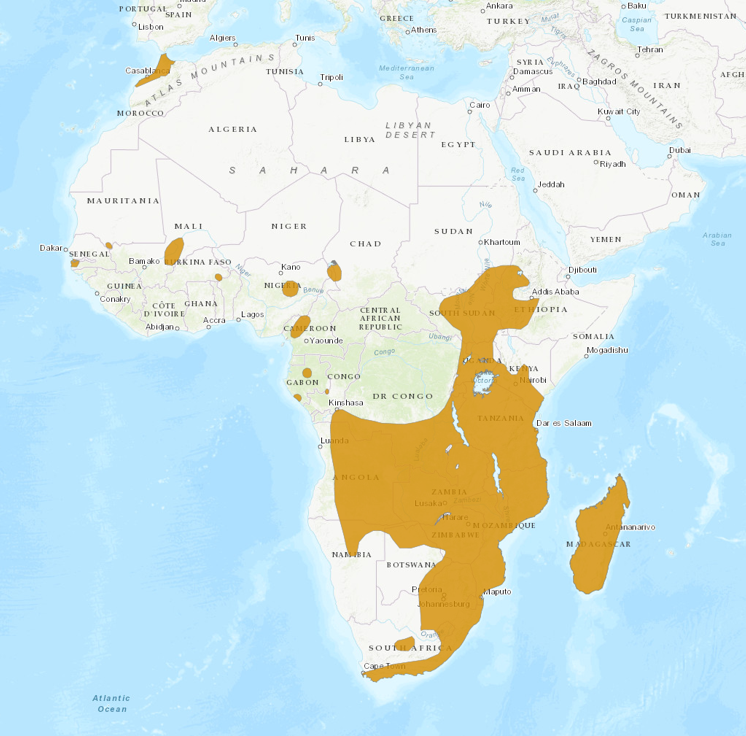
Approximate distribution of the Marsh Owl. © BirdLife International 2021
Comprises three recognized subspecies:
The nominate race is resident in sub-Saharan Africa discontinuously from Senegal east to Ethiopia and south to South Africa.
The critically endangered tingitanus is resident in north-coastal Morocco.
The distinctive hova is resident on Madagascar.
In Morocco, the tiny relict population of tingitanus inhabits the coastal plain between Rabat and Tangier, with the majority in wetlands around the lagoon Merja Zerga.
Elsewhere in western Africa, it is thinly distributed in the Sahel from Senegal and Guinea east to the Lake Chad depression, south locally to interior savannas of Gabon and the Republic of the Congo.
In eastern and southern Africa, it occurs more or less contiguously from southern Uganda and central Kenya south to the eastern half of South Africa and west in a wide band through Zambia, the southern D.R.C., and northern and central Botswana to Angola and northern Namibia. It also occurs sporadically (or very locally) north into south-western Ethiopia and southwest to Western Cape Province.

Distribution of the Marsh Owl in southern Africa based on records from the SA Bird Atlas Project. © Biodiversity Explorer 2023
On Madagascar, hova has been recorded from near the northern tip of the island to the far south. Most records are from the central-east, south-central, and southwest.
Identification
A mostly-brown open-country owl that often hunts on the wing, flying low over grasslands and marshes, with a meandering, harrier-like flight pattern that alternates between deep, floppy wingbeats and long glides. Partly diurnal, but mostly active at night and around dusk.
The plumage is mainly brown overall, varying in tone from warm and reddish to cold and dark, with a paler facial disk and prominent dark eyes.
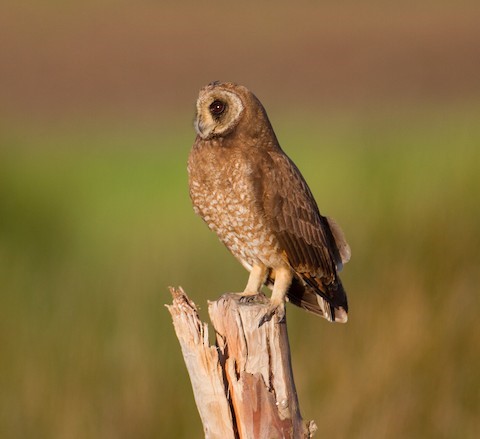
Marsh Owl, showing solid-brown upperparts and barred underparts with a mostly solid-brown chest. (Merja Zerga, Morocco; February 27, 2010.) © Jose Martin

Marsh Owl, showing mostly solid-brown upperparts with a few white spots. (Nylsvley Nature Reserve, Limpopo, South Africa; September 7, 2012.) © Don-Jean Léandri-Breton
The upperparts are mostly solid brown, sometimes with a few pale spots. The chest is mostly solid brown and the lower breast and belly and barred.
The eyes appear very large in part because they are surrounded by blackish feathers. Short ear-tufts on the forecrown are usually held flat, but sometimes raised.
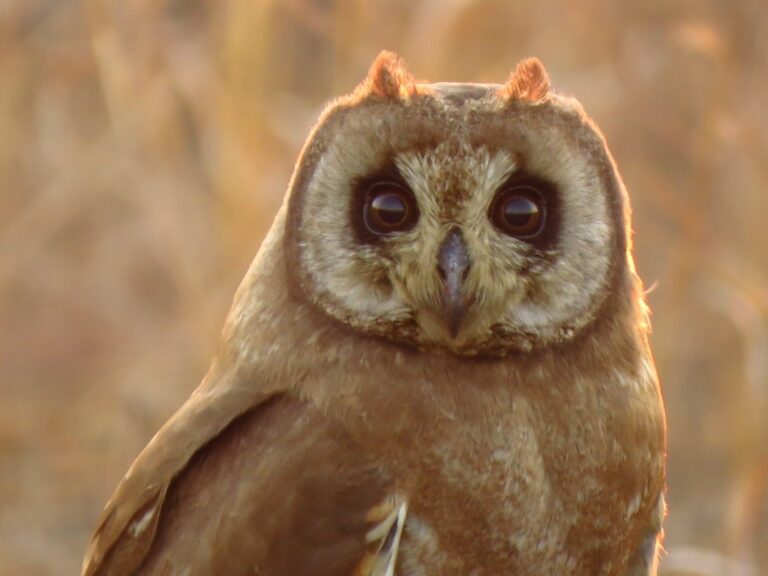
Marsh Owl, close-up showing dark-shadowed eyes and ear-tufts raised. (Rietvallei, Pretoria, South Africa; June 29, 2021.) © Madeleen van Schalkwyk
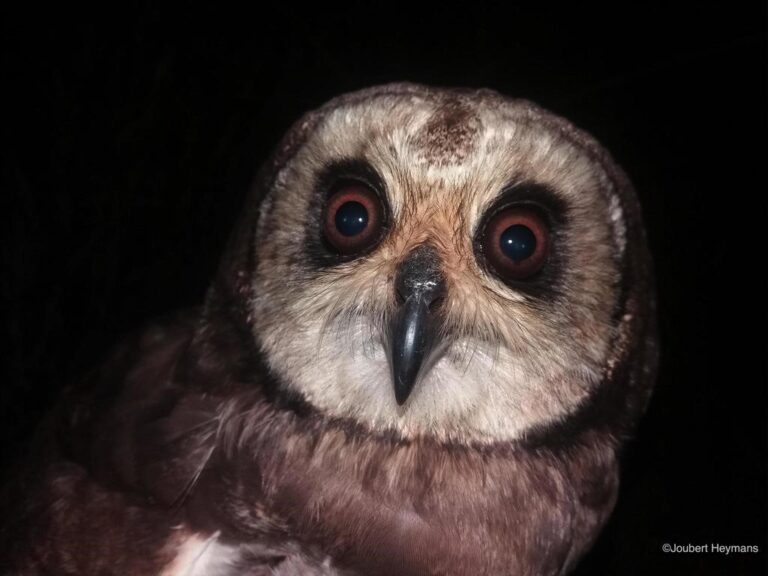
Marsh Owl, close-up of an individual with relatively cold-toned, dark-brown plumage and much paler facial disk. (Rust de Winter, Limpopo, South Africa; March 25, 2017.) © Joubert Heymans
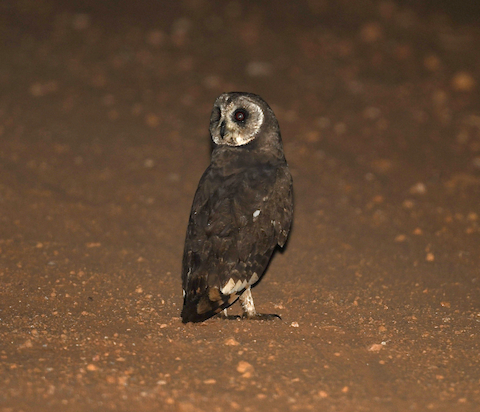
Marsh Owl, a dark-brown individual. (Kalola, Zambia; March 14, 2022.) © Joseph Tobias
Juveniles are warm-brown overall, with heavily spotted upperparts.

Marsh Owl, juvenile. (Rietvallei, Pretoria, South Africa; May 19, 2023.) © tjeerd

Marsh Owl, dorsal view in flight, showing cinnamon patches in the primaries. (Bié, Angola; February 2023.) © Rogerio Ferreira
In flight, the upperside of the wing appears mostly solid-brown with a large cinnamon patch in the primaries.
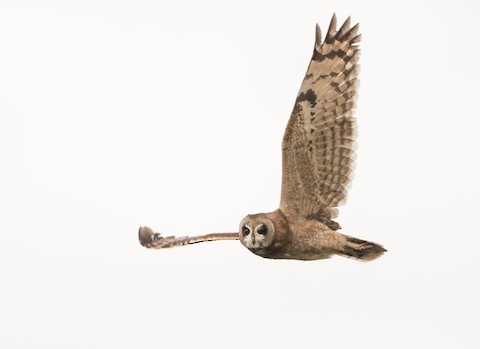
Marsh Owl, ventral view in flight, showing dark crescents in the primaries. (Dlalha, Morocco; May 3, 2022.) © John Sterling
The underside of the wing is mostly pale with a prominent black crescent at the base of the primaries, and typically shows one or two additional dark crescents near the tips of the primaries.
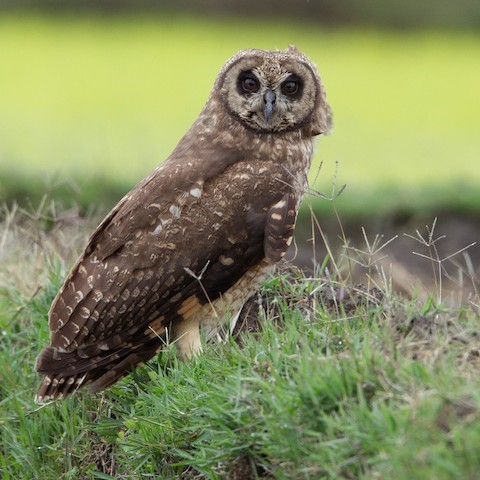
Marsh Owl, A. c. hova, showing mottled upperparts typical of this subspecies. (Andasibe-Mananara, Toamasina, Madagascar; November 21, 2010.) © Werner Suter
The Madagascan subspecies hova measures about 15% than the continental populations, and is more strongly patterned on both the upperparts and the underparts, including the underwings.
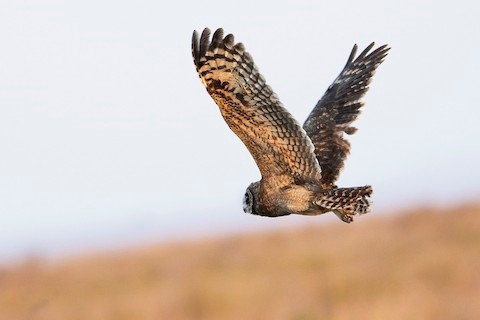
Marsh Owl, A. c. hova, in flight, showing the extensive barring typical of this subspecies. (Nanarena, Fianarantsoa, Madagascar; September 16, 2014.) © Miguel Rouco
Notes
Polytypic species consisting of three recognized subspecies. The Madagascan subspecies hova is significantly larger and more heavily patterned than the continental subspecies, but the consistency and potential taxonomic significance of these differences does not appear to be well-studied.
More Images of the Marsh Owl
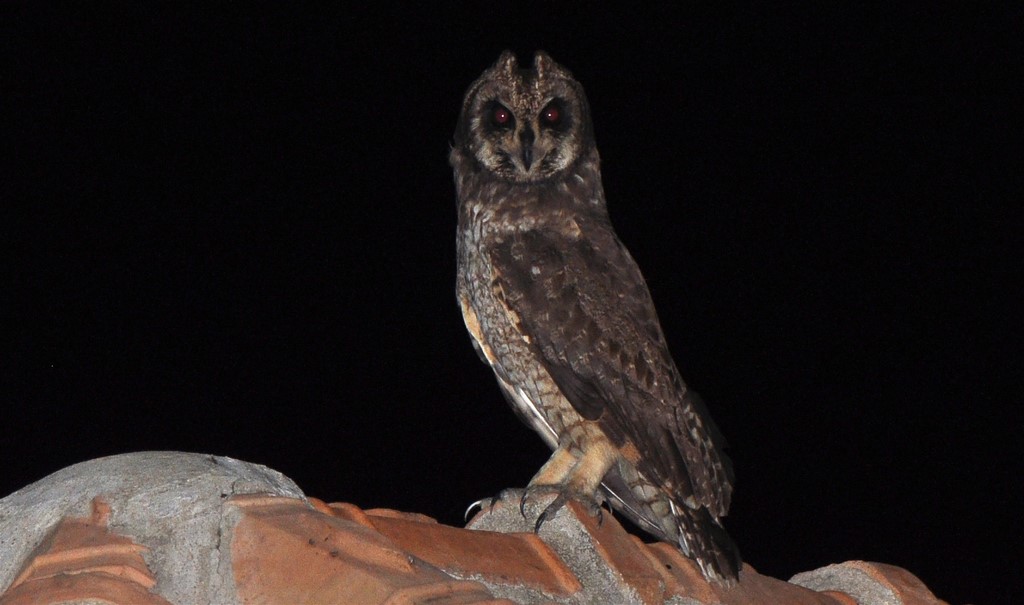
Marsh Owl, A. c. hova. (Ambalavao, Madagascar; March 6, 2013.) © CORDENOS Thierry
References
Biodiversity Explorer. 2023. Asio capensis (Marsh owl). http://www.biodiversityexplorer.info/birds/strigidae/asio_capensis.htm. (Accessed June 13, 2023.)
BirdLife International. 2021. Asio capensis. The IUCN Red List of Threatened Species 2021: e.T22689535A202174205. https://dx.doi.org/10.2305/IUCN.UK.2021-3.RLTS.T22689535A202174205.en. (Accessed June 13, 2023.)
Borrow, N., and R. Demey. 2004. Birds of Western Africa. Princeton University Press.
eBird. 2023. eBird: An online database of bird distribution and abundance. Cornell Lab of Ornithology, Ithaca, N.Y. http://www.ebird.org. (Accessed June 13, 2023.)
Hollom, P.A.D., R.F. Porter, S. Christensen, and I. Willis. 1988. Birds of the Middle East and North Africa. T & AD Poyser, Calton, England.
iNaturalist. 2023. https://www.inaturalist.org/. (Accessed June 13, 2023.)
König, C., and F. Weick. 2008. Owls of the World (Second Edition). Yale University Press.
Mikkola, H. 2012. Owls of the World: A Photographic Guide. Firefly Books, London.
Mullarney, K., L. Svensson, D. Zetterström, and P.J. Grant. 1999. Birds of Europe. Princeton University Press.
Owl Pages. 2023. Marsh Owl ~ Asio capensis. https://www.owlpages.com/owls/species.php?s=3610. (Accessed June 13, 2023.)
Redman, R., T. Stevenson, T., and J. Fanshawe. 2009. Birds of the Horn of Africa: Ethiopia, Eritrea, Djibouti, Somalia, and Socotra. Princeton University Press.
Sinclair, I., and P. Ryan. 2003. Birds of Africa South of the Sahara. Princeton University Press.
Sinclair, I., P. Hockey, W. Tarboton, and P. Ryan. 2011. Birds of Southern Africa (Fourth Edition). Random House Struik (Pty) Ltd. Cape Town, South Africa.
van Perlo, B. 1999. Birds of Southern Africa. Princeton University Press.
van Perlo, B. 2002. Birds of Western and Central Africa. Princeton University Press.
Xeno-Canto. 2023. Marsh Owl – Asio capensis. https://xeno-canto.org/species/Asio-capensis. (Accessed June 13, 2023.)
